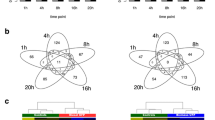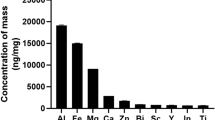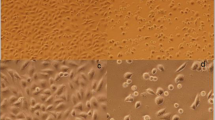Abstract
Urban particulate matter (PM), a great danger to public health, is associated with increasing risk of pulmonary diseases. However, the involved key genes and signaling pathways mediating the cellular responses to urban PM are largely unknown. In this study, human bronchial epithelial cells BEAS-2B was exposed to Standard reference material (SRM) 1649b, followed by RNA-sequencing (RNA-seq) and a combination of different bioinformatics analysis. A total of 201 genes (111 upregulated and 90 downregulated) were identified as the differentially expressed genes (DEGs). Moreover, Gene Ontology (GO), Kyoto Encyclopedia of Genes and Genomes (KEGG), and gene set enrichment analysis (GSEA) unveiled several significant genes and pathways involved in PM-induced lung toxicity. Protein-protein interaction (PPI) network was performed with the Search Tool for the Retrieval of Interacting Genes (STRING), and the hub gene modules were recognized by Molecular Complex Detection (MCODE), a plug-in of Cytoscape. Moreover, Connectivity Map (CMap) analysis found six candidate small molecular compounds to reverse PM-altered gene expression, including aminohippuric acid, captopril, cinoxacin, fasudil, pargyline, and altizide. Finally, the expressions of part vital genes related to inflammation (IL-1β, CXCL2, CXCL5, CXCL8), ferroptosis (HMOX1, GCLM), and autophagy (BECN1, MAPK1LC3B) were in accordance with the RNA-seq data, with a concentration-dependent manner. This study may be helpful in revealing the complex molecular mechanisms underlying PM-induced lung toxicity and provide some new therapeutic targets for PM-related pulmonary diseases.








Similar content being viewed by others
Data Availability
All data generated or analyzed during this study are included in this published article (and its supplementary information files).
References
Abbas I, Verdin A, Escande F, Saint-Georges F, Cazier F, Mulliez P, Courcot D, Shirali P, Gosset P, Garcon G (2016) In vitro short-term exposure to air pollution PM2.5-0.3 induced cell cycle alterations and genetic instability in a human lung cell coculture model. Environ Res 147:146–158
Abdalkader M, Lampinen R, Kanninen KM, Malm TM, Liddell JR (2018) Targeting Nrf2 to suppress ferroptosis and mitochondrial dysfunction in neurodegeneration. Front Neurosci 12:466
Araujo JA, Nel AE (2009) Particulate matter and atherosclerosis: role of particle size, composition and oxidative stress. Part Fibre Toxicol 6:24
Bell ML, Davis DL (2001) Reassessment of the lethal London fog of 1952: novel indicators of acute and chronic consequences of acute exposure to air pollution. Environ Health Perspect 109(Suppl 3):389–394
Boskabadi J, Mokhtari-Zaer A, Abareshi A, Khazdair MR, Emami B, Mohammadian RN, Hosseini M, Boskabady MH (2018) The effect of captopril on lipopolysaccharide-induced lung inflammation. Exp Lung Res 44:191–200
Boskabadi J, Askari VR, Hosseini M, Boskabady MH (2019) Immunomodulatory properties of captopril, an ACE inhibitor, on LPS-induced lung inflammation and fibrosis as well as oxidative stress. Inflammopharmacology 27:639–647
Chen J, Hoek G (2020) Long-term exposure to PM and all-cause and cause-specific mortality: A systematic review and meta-analysis. Environ Int:105974
Chen ZH, Wu YF, Wang PL, Wu YP, Li ZY, Zhao Y, Zhou JS, Zhu C, Cao C, Mao YY, Xu F, Wang BB, Cormier SA, Ying SM, Li W, Shen HH (2016) Autophagy is essential for ultrafine particle-induced inflammation and mucus hyperproduction in airway epithelium. Autophagy 12:297–311
Darrow LA, Klein M, Flanders WD, Mulholland JA, Tolbert PE, Strickland MJ (2014) Air pollution and acute respiratory infections among children 0-4 years of age: an 18-year time-series study. Am J Epidemiol 180:968–977
Doerner AM, Zuraw BL (2009) TGF-beta1 induced epithelial to mesenchymal transition (EMT) in human bronchial epithelial cells is enhanced by IL-1beta but not abrogated by corticosteroids. Respir Res 10:100
GBD 2015 Risk Factors Collaborators (2016) Global, regional, and national comparative risk assessment of 79 behavioural, environmental and occupational, and metabolic risks or clusters of risks, 1990-2015: a systematic analysis for the Global Burden of Disease Study 2015. Lancet 388:1659–1724
Georas SN, van Wijngaarden E, Rich DQ (2015) Air pollution and asthma incidence: doubt no more? Lancet Respir Med 3:902–903
Grilli A, Bengalli R, Longhin E, Capasso L, Proverbio MC, Forcato M, Bicciato S, Gualtieri M, Battaglia C, Camatini M (2018) Transcriptional profiling of human bronchial epithelial cell BEAS-2B exposed to diesel and biomass ultrafine particles. BMC Genomics 19:302
Hirota JA, Hirota SA, Warner SM, Stefanowicz D, Shaheen F, Beck PL, Macdonald JA, Hackett TL, Sin DD, Van Eeden S, Knight DA (2012) The airway epithelium nucleotide-binding domain and leucine-rich repeat protein 3 inflammasome is activated by urban particulate matter. J Allergy Clin Immunol 129:1116–1125
Kensler TW, Wakabayashi N, Biswal S (2007) Cell survival responses to environmental stresses via the Keap1-Nrf2-ARE pathway. Annu Rev Pharmacol Toxicol 47:89–116
Li Z, Carter JD, Dailey LA, Huang YC (2005) Pollutant particles produce vasoconstriction and enhance MAPK signaling via angiotensin type I receptor. Environ Health Perspect 113:1009–1014
Lin CI, Tsai CH, Sun YL, Hsieh WY, Lin YC, Chen CY, Lin CS (2018) Instillation of particulate matter 2.5 induced acute lung injury and attenuated the injury recovery in ACE2 knockout mice. Int J Biol Sci 14:253–265
Malhotra D, Portales-Casamar E, Singh A, Srivastava S, Arenillas D, Happel C, Shyr C, Wakabayashi N, Kensler TW, Wasserman WW, Biswal S (2010) Global mapping of binding sites for Nrf2 identifies novel targets in cell survival response through ChIP-Seq profiling and network analysis. Nucleic Acids Res 38:5718–5734
Manzano-Leon N, Serrano-Lomelin J, Sanchez BN, Quintana-Belmares R, Vega E, Vazquez-Lopez I, Rojas-Bracho L, Lopez-Villegas MT, Vadillo-Ortega F, De Vizcaya-Ruiz A, Perez IR, O'Neill MS, Osornio-Vargas AR (2016) TNFalpha and IL-6 Responses to particulate matter in vitro: variation according to pm size, season, and polycyclic aromatic hydrocarbon and soil content. Environ Health Perspect 124:406–412
Orellano P, Reynoso J, Quaranta N, Bardach A, Ciapponi A (2020) Short-term exposure to particulate matter (PM10 and PM2.5), nitrogen dioxide (NO2), and ozone (O3) and all-cause and cause-specific mortality: Systematic review and meta-analysis. Environ Int 142:105876
Pardo M, Shafer MM, Rudich A, Schauer JJ, Rudich Y (2015) Single exposure to near roadway particulate matter leads to confined inflammatory and defense responses: possible role of metals. Environ Sci Technol 49:8777–8785
Pope CR, Burnett RT, Turner MC, Cohen A, Krewski D, Jerrett M, Gapstur SM, Thun MJ (2011) Lung cancer and cardiovascular disease mortality associated with ambient air pollution and cigarette smoke: shape of the exposure-response relationships. Environ Health Perspect 119:1616–1621
Raaschou-Nielsen O, Andersen ZJ, Beelen R, Samoli E, Stafoggia M, Weinmayr G, Hoffmann B, Fischer P, Nieuwenhuijsen MJ, Brunekreef B, Xun WW, Katsouyanni K, Dimakopoulou K, Sommar J, Forsberg B, Modig L, Oudin A, Oftedal B, Schwarze PE, Nafstad P, De Faire U, Pedersen NL, Ostenson CG, Fratiglioni L, Penell J, Korek M, Pershagen G, Eriksen KT, Sorensen M, Tjonneland A, Ellermann T, Eeftens M, Peeters PH, Meliefste K, Wang M, Bueno-de-Mesquita B, Key TJ, de Hoogh K, Concin H, Nagel G, Vilier A, Grioni S, Krogh V, Tsai MY, Ricceri F, Sacerdote C, Galassi C, Migliore E, Ranzi A, Cesaroni G, Badaloni C, Forastiere F, Tamayo I, Amiano P, Dorronsoro M, Trichopoulou A, Bamia C, Vineis P, Hoek G (2013) Air pollution and lung cancer incidence in 17 European cohorts: prospective analyses from the European Study of Cohorts for Air Pollution Effects (ESCAPE). Lancet Oncol 14:813–822
Schikowski T, Ranft U, Sugiri D, Vierkotter A, Bruning T, Harth V, Kramer U (2010) Decline in air pollution and change in prevalence in respiratory symptoms and chronic obstructive pulmonary disease in elderly women. Respir Res 11:113
Sese L, Nunes H, Cottin V, Sanyal S, Didier M, Carton Z, Israel-Biet D, Crestani B, Cadranel J, Wallaert B, Tazi A, Maitre B, Prevot G, Marchand-Adam S, Guillot-Dudoret S, Nardi A, Dury S, Giraud V, Gondouin A, Juvin K, Borie R, Wislez M, Valeyre D, Annesi-Maesano I (2018) Role of atmospheric pollution on the natural history of idiopathic pulmonary fibrosis. Thorax 73:145–150
Shang Y, Sun Z, Cao J, Wang X, Zhong L, Bi X, Li H, Liu W, Zhu T, Huang W (2013) Systematic review of Chinese studies of short-term exposure to air pollution and daily mortality. Environ Int 54:100–111
Sun H, Shamy M, Kluz T, Munoz AB, Zhong M, Laulicht F, Alghamdi MA, Khoder MI, Chen LC, Costa M (2012) Gene expression profiling and pathway analysis of human bronchial epithelial cells exposed to airborne particulate matter collected from Saudi Arabia. Toxicol Appl Pharmacol 265:147–157
Vattanasit U, Navasumrit P, Khadka MB, Kanitwithayanun J, Promvijit J, Autrup H, Ruchirawat M (2014) Oxidative DNA damage and inflammatory responses in cultured human cells and in humans exposed to traffic-related particles. Int J Hyg Environ Health 217:23–33
Vincent R, Goegan P, Johnson G, Brook JR, Kumarathasan P, Bouthillier L, Burnett RT (1997) Regulation of promoter-CAT stress genes in HepG2 cells by suspensions of particles from ambient air. Fundam Appl Toxicol 39:18–32
Wang Y, Tang M (2019) PM2.5 induces ferroptosis in human endothelial cells through iron overload and redox imbalance. Environ Pollut 254:112937
Wang Y, Wang X, Liu W, Zhang L (2018) Role of the Rho/ROCK signaling pathway in the protective effects of fasudil against acute lung injury in septic rats. Mol Med Rep 18:4486–4498
Wu YF, Li ZY, Dong LL, Li WJ, Wu YP, Wang J, Chen HP, Liu HW, Li M, Jin CL, Huang HQ, Ying SM, Li W, Shen HH, Chen ZH (2020) Inactivation of MTOR promotes autophagy-mediated epithelial injury in particulate matter-induced airway inflammation. Autophagy 16:435–450
Xie T, Luo G, Zhang Y, Wang X, Wang X, Wu M, Li G (2015) Rho-kinase inhibitor fasudil reduces allergic airway inflammation and mucus hypersecretion by regulating STAT6 and NFkappaB. Clip Exp Allergy 45:1812–1822
Xu H, Bi XH, Zheng WW, Wu JH, Feng YC (2015) Particulate matter mass and chemical component concentrations over four Chinese cities along the western Pacific coast. Environ Sci Pollut Res Int 22:1940–1953
Ying Z, Yue P, Xu X, Zhong M, Sun Q, Mikolaj M, Wang A, Brook RD, Chen LC, Rajagopalan S (2009) Air pollution and cardiac remodeling: a role for RhoA/Rho-kinase. Am J Physiol Heart Circ Physiol 296:H1540–H1550
Yoshida M, Minagawa S, Araya J, Sakamoto T, Hara H, Tsubouchi K, Hosaka Y, Ichikawa A, Saito N, Kadota T, Sato N, Kurita Y, Kobayashi K, Ito S, Utsumi H, Wakui H, Numata T, Kaneko Y, Mori S, Asano H, Yamashita M, Odaka M, Morikawa T, Nakayama K, Iwamoto T, Imai H, Kuwano K (2019) Involvement of cigarette smoke-induced epithelial cell ferroptosis in COPD pathogenesis. Nat Commun 10:3145
Zanobetti A, Schwartz J (2006) Air pollution and emergency admissions in Boston, MA. J Epidemiol Community Health 60:890–895
Zhang M, Zhang Z, Pan HY, Wang DX, Deng ZT, Ye XL (2009) TGF-beta1 induces human bronchial epithelial cell-to-mesenchymal transition in vitro. Lung 187:187–194
Zhang X, Chen Y, Wei H, Qin Y, Hao Y, Zhu Y, Deng F, Guo X (2014) Ultrafine carbon black attenuates the antihypertensive effect of captopril in spontaneously hypertensive rats. Inhal Toxicol 26:853–860
Zheng R, Tao L, Jian H, Chang Y, Cheng Y, Feng Y, Zhang H (2018) NLRP3 inflammasome activation and lung fibrosis caused by airborne fine particulate matter. Ecotoxicol Environ Saf 163:612–619
Zhou X, Cao Z, Ma Y, Wang L, Wu R, Wang W (2016) Concentrations, correlations and chemical species of PM2.5/PM10 based on published data in China: potential implications for the revised particulate standard. Chemosphere 144:518–526
Zhuang R, Wu J, Lin F, Han L, Liang X, Meng Q, Jiang Y, Wang Z, Yue A, Gu Y, Fan H, Zhou X, Liu Z (2018) Fasudil preserves lung endothelial function and reduces pulmonary vascular remodeling in a rat model of endstage pulmonary hypertension with left heart disease. Int J Mol Med 42:1341–1352
Funding
This study was supported by the State Key Basic Research Program project (2015CB553404), the National Natural Science Foundation of China (81630001, 81770075, 82041003), Science and Technology Commission of Shanghai Municipality (20411950402), Shanghai Municipal Key Clinical Specialty (shslczdzk02201) and Shanghai Top-Priority Clinical Key Disciplines Construction Project (2017ZZ02013), National Major Scientific and Technological Special Project for “Significant New Drugs Development” (2018ZX09201002-006).
Author information
Authors and Affiliations
Contributions
Jue Pan and Yuanlin Song designed and supervised the study. Mengchan Zhu, Jian Wang, and Cuicui Chen performed the experiments. Mengchan Zhu and Cuicui Chen analyzed and interpreted the data. Mengchan Zhu and Jian Wang drew the figures and wrote the manuscript.
Corresponding authors
Ethics declarations
Conflicts of interests
The authors have no competing interests.
Ethical approval
Not applicable
Consent to participate
The authors have consent to participate.
Consent to publish
The authors have consent to publish.
Additional information
Responsible Editor: Mohamed M. Abdel-Daim
Publisher’s note
Springer Nature remains neutral with regard to jurisdictional claims in published maps and institutional affiliations.
Electronic supplementary material
ESM 1
(DOCX 119 kb)
Rights and permissions
About this article
Cite this article
Zhu, M., Wang, J., Chen, C. et al. Transcriptomic analysis of key genes and pathways in human bronchial epithelial cells BEAS-2B exposed to urban particulate matter. Environ Sci Pollut Res 28, 9598–9609 (2021). https://doi.org/10.1007/s11356-020-11347-1
Received:
Accepted:
Published:
Issue Date:
DOI: https://doi.org/10.1007/s11356-020-11347-1




